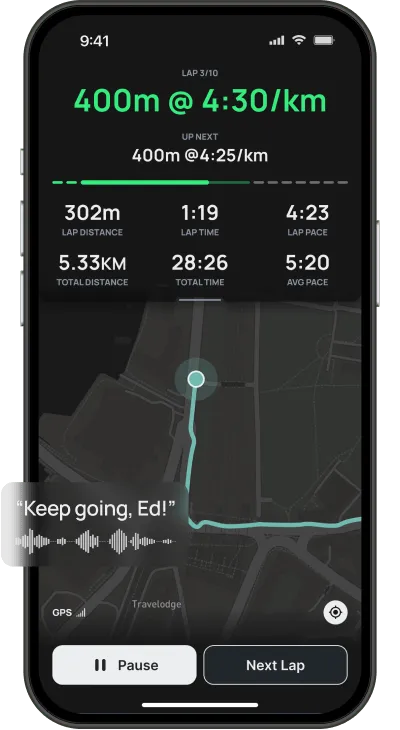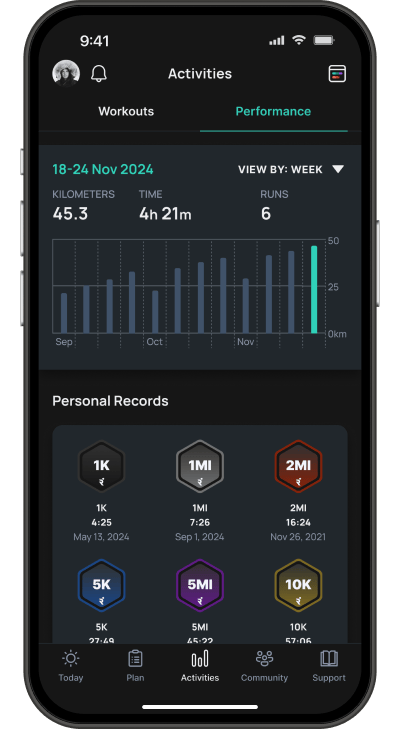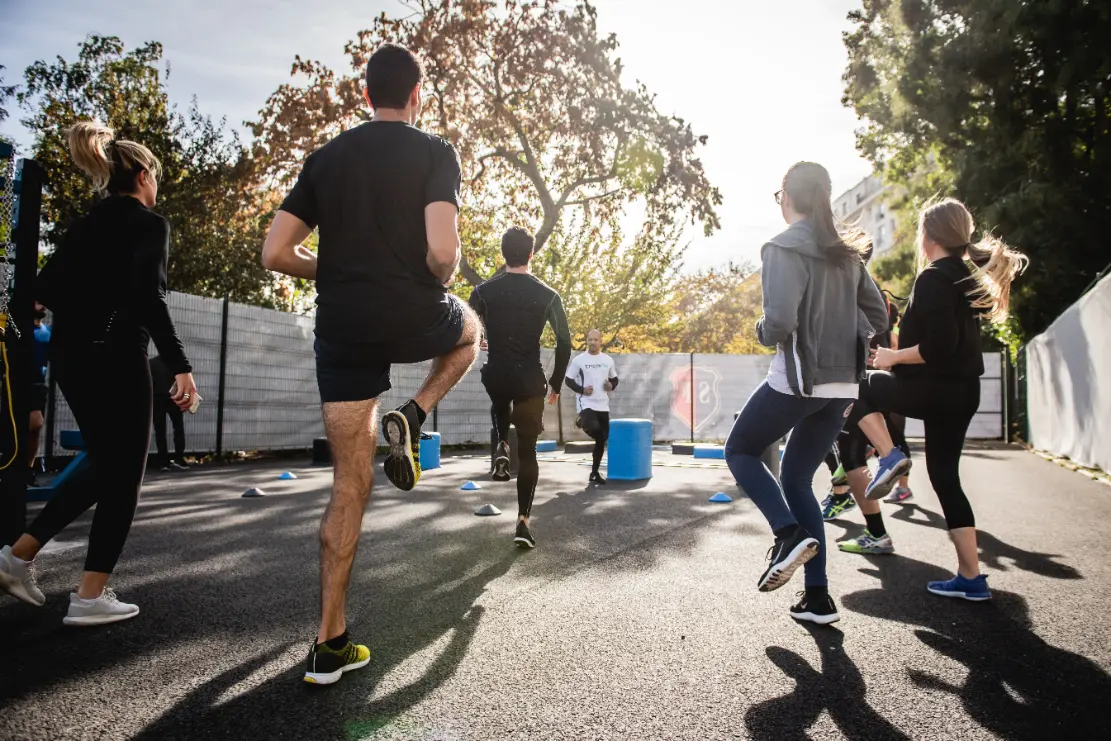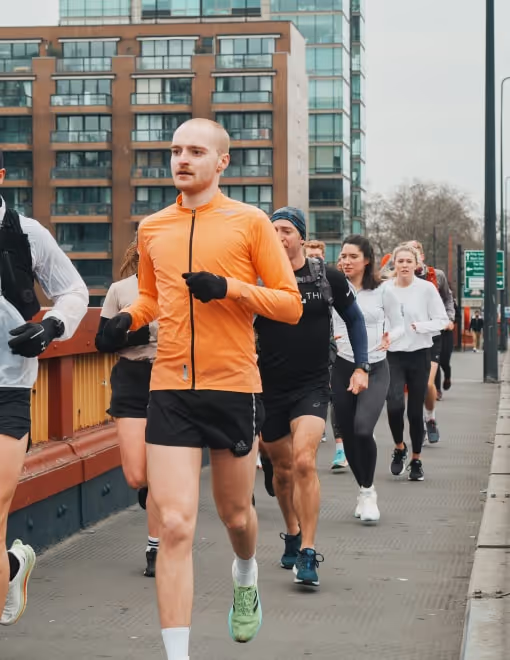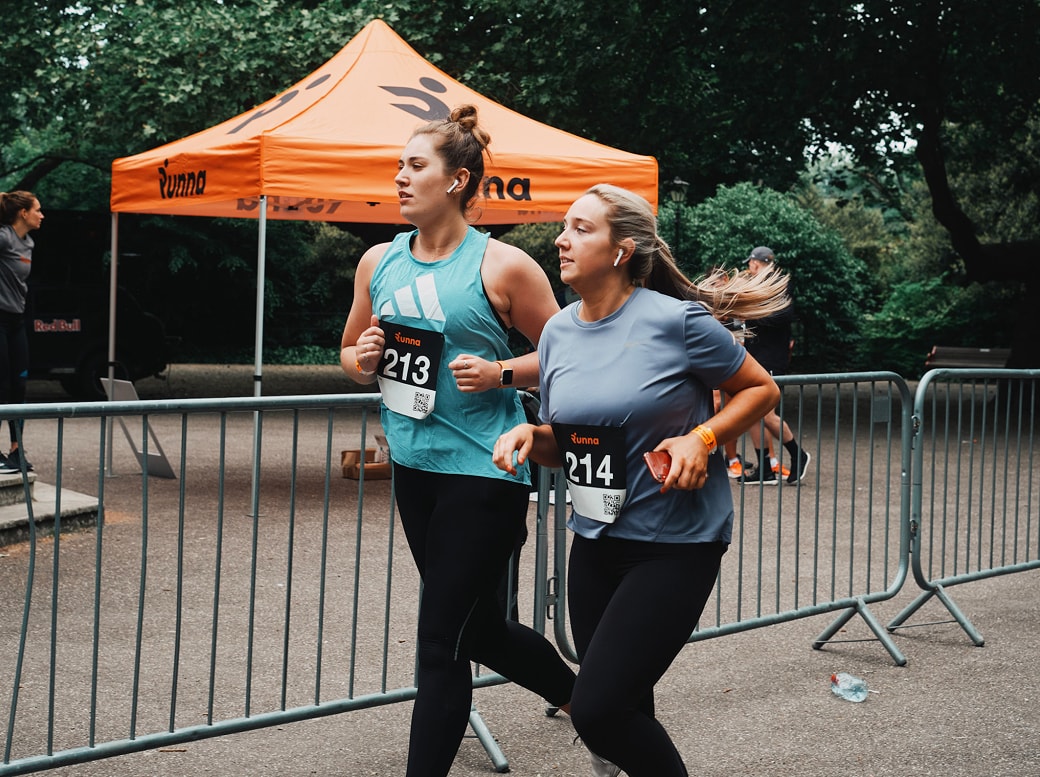Triathlon Training Plan
Whether it’s your first triathlon or you’re chasing a new personal best, the key is structured training across all three disciplines. With the right plan, you’ll gain the endurance, resilience, and race-day strategy to make the finish line yours.
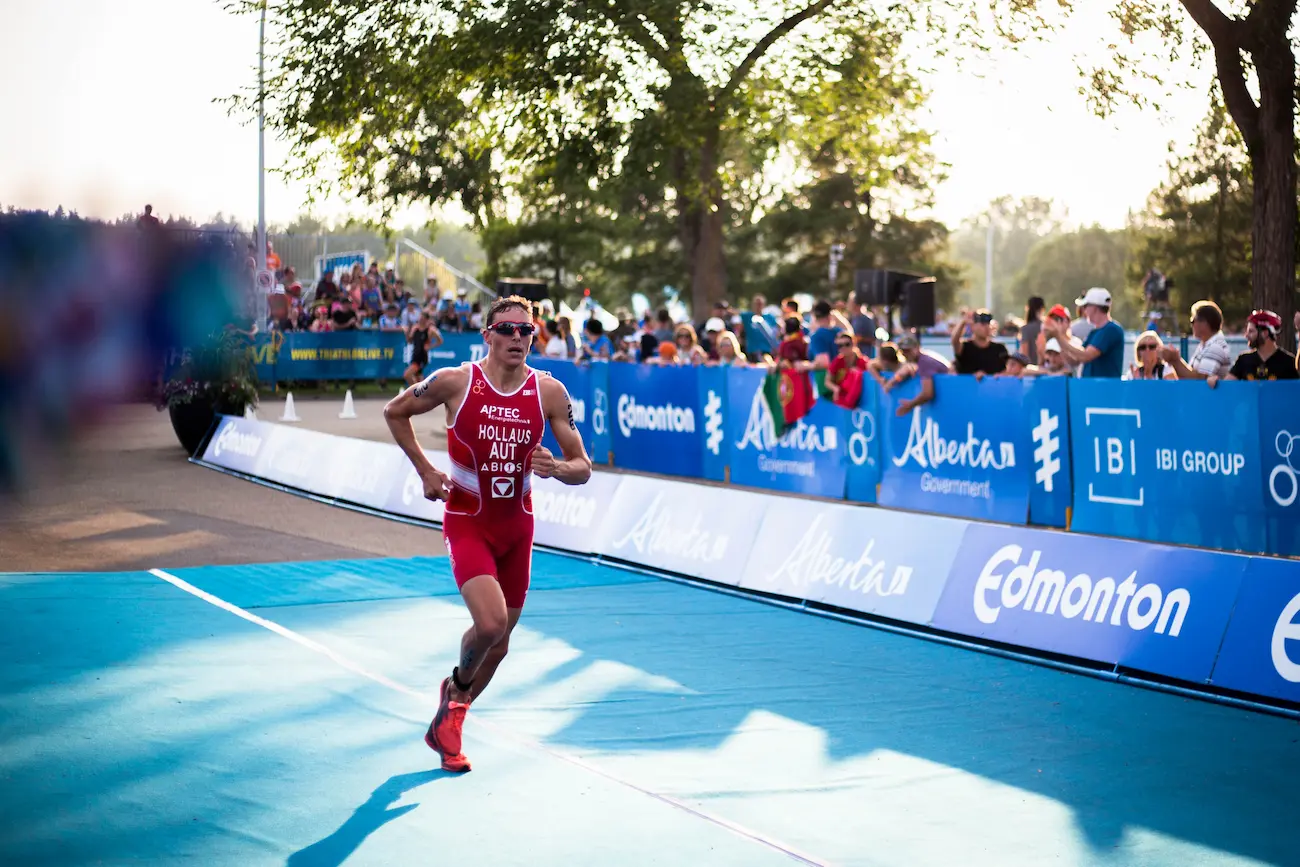
How to train for a triathlon
A triathlon is an endurance race that combines swimming, cycling, and running - always in that order. Distances vary, from shorter sprint events all the way up to the Ironman:
• Ironman: 3.8 km swim, 180 km bike, 42.2 km run (226 km total)
• Half Ironman (70.3): 1.9 km swim, 90 km bike, 21.1 km run (113 km total)
• Olympic: 1.5 km swim, 40 km bike, 10 km run (51.5 km total)
• Sprint: 0.75 km swim, 20 km bike, 5 km run (25.75 km total)
Triathlon training is demanding - it pushes your endurance, resilience, and mental grit across three sports - but the variety also keeps it fresh and rewarding. Once you complete your first race, it’s easy to see why so many athletes come back for more.
Training well means balancing all three disciplines in a way that’s sustainable. That might look like following the 80/20 principle (80% of training easy, 20% harder efforts), making your sessions social by joining a club, and committing to a routine that fits your lifestyle. The real key is structure: a plan that manages your swim, bike, and run while keeping you consistent and accountable.
That’s where Runna comes in. We’ll create a personalized triathlon program built around your fitness, distance, and goals - and we’ll guide you through every step, from your first session to the finish line.

Why choose our triathlon training plan?
Whatever your triathlon distance or experience, we’ll give you the structure, support, and personalization you need to fit running into your swim-bike routine and reach your goals.
How to get started
Runna takes the guesswork out of triathlon prep. We’ll handle the running - so you can focus on racing stronger, faster, and more confident.
Choose your plan
Tell us your race - Sprint, Olympic, Half Ironman, or Ironman - and we'll create a plan that adapts to your fitness and schedule.
Download the app
Download the app, log in, and you’ll have your full training plan - complete with runs, tips, and guidance - at your fingertips.
Run, run, run!
Simply tap ‘Go’ and follow along. Every run is laid out clearly, so you always know exactly what to do.
Hit that goal
Be consistent and we’ll get you to race day ready to smash your triathlon - strong, confident, and proud of what you’ve achieved.
Workouts explained
Your triathlon training includes a mix of sessions - each with a clear purpose. Here’s what they are and how they’ll help you on race day.
Tips for your triathlon training plan
These expert-backed tips will help you train smarter, avoid injury, and stay motivated. From pacing and recovery to gear and mindset, discover just a small snippet of all the tips, nutrition and coaching advice you'll have at your fingertips with a Runna training plan.
Nutrition
Training is only part of the equation - what you eat has a big impact on how you feel and perform. With three disciplines back-to-back, your body needs the right energy at the right time.
- Day-to-day training: As your training volume increases, so does your energy demand. Keep protein high for muscle repair, and use carbs as your main fuel for tougher sessions. Complex carbs like oats, rice, whole grains, fruits, and vegetables give you steady energy.
- During training and racing: Because you can’t eat while swimming, the bike is your main fueling opportunity. Practice with gels, bars, or drinks on long rides so you know what works for you. Training your gut is as important as training your legs.
- Race week and race day: In the final week, reduce volume and increase the proportion of carbs in your meals to top up glycogen. Keep protein steady, lower fiber three days before, and avoid high fat. On race morning, eat a carb-rich meal 2-4 hours before the start - tried and tested from training.
Remember: Nutrition is personal. Use training to experiment and race day to execute a plan you trust.

Strength training
Strength training is one of the most effective ways to boost triathlon performance. It makes you more efficient, more resilient, and more powerful across all three disciplines.
- Running: Stronger muscles improve your running economy by 8–12%, meaning you use less energy at the same pace and hold form longer off the bike.
- Cycling: Leg and core strength give you more power on climbs, stability on descents, and endurance for long rides.
- Swimming: Upper-body and core strength improve stroke efficiency and help maintain good form when fatigue sets in.
It also protects you against injury. During running, for example, your calves can absorb up to 11x your bodyweight in force and your quads up to 4x. Strength training conditions your muscles to handle these loads, reducing the strain on joints and bones.
With Runna, you’ll get a personalized strength program designed to slot seamlessly into your triathlon training. It adapts to your current ability, weekly schedule, and available equipment - from full gym setups to simple bodyweight sessions.

Pacing and balancing swim, bike and run
Triathlon success comes down to balance - in training and on race day. Each sport matters, but how you combine them determines how strong you finish.
In training:
- Running: Focus on consistent, quality runs that fit around your swim and bike sessions.
- Cycling & swimming: Build mileage gradually with a mix of easy, tempo, and harder efforts.
- Brick sessions: Practice running off the bike to adapt to heavy legs and find rhythm faster.
- Volume & intensity: Follow the 80/20 rule - mostly easy, some hard - to build fitness without burnout.
On race day:
- Pace yourself early - especially in the swim and bike. Pushing too hard in the first two legs can leave you with nothing left for the run.
- Think of your race as one long effort, not three separate ones. Stay controlled in the water, efficient on the bike, and steady in the first half of the run.
- Break it into sections. Focus on each discipline and even smaller checkpoints (the next buoy, the next 10k on the bike, the next aid station on the run).
- Stick to your fueling plan from the start - don’t wait until you feel tired.
- Remember: Balance your energy across swim, bike, and run, and you’ll arrive at the finish line stronger - not just surviving the last leg, but finishing proud.
.webp)
Form
Form is the foundation of efficiency in a triathlon. Over long distances and across three sports, even small improvements in technique can save you huge amounts of energy.
- Swimming: Efficient form helps you glide through the water instead of fighting it, conserving energy for the bike and run.
- Cycling: Smooth pedaling and relaxed posture reduce wasted effort, keeping your legs fresher for the run.
- Running: Good posture, short strides, and relaxed shoulders allow you to maintain rhythm and hold strong form even on tired legs.
Strong form means less wasted energy, lower injury risk, and greater resilience when fatigue sets in. In a triathlon, it’s not just about speed - it’s about sustaining efficiency hour after hour.
Form is something you’ve developed over a lifetime, so changes might feel strange at first. Be patient and focus on small improvements. Work on form during training so it feels natural by race day. Focus especially on the later kilometers of long runs or workouts, when holding good posture matters most.
With Runna, you’ll get reminders and cues in your plan that help you focus on form during key sessions, so it becomes second nature on race day.
%20(1).webp)
Recovery
Training only works if your body has time to adapt. Recovery keeps you consistent and injury-free over the full training block.
Here are the key things to focus on:
- Sleep: Aim for 7-9 hours each night. Quality sleep is when your body repairs, adapts, and rebuilds strength after long sessions.
- Mobility work: Add yoga, Pilates, or stretching into your week to offset stiffness from cycling and running, and to keep your range of motion for swimming.
- Massage and tools: Use a foam roller, massage gun, or occasional sports massage to release tight muscles and speed up recovery.
- Nutrition and hydration: Refuel after tough sessions with carbs and protein to replenish glycogen and repair muscle. Hydrate consistently, as even small deficits can add up across multi-sport training.
- Active recovery: Easy swimming, cycling, or walking improves circulation and loosens sore muscles without adding more fatigue.
- Flexibility: Listen to your body. If you feel unusually tired or sore, swap a session or take an extra rest day. Adjusting keeps you progressing - pushing through fatigue risks setbacks.
After a triathlon race, your body will need longer to bounce back than after a single-discipline event. Give yourself several easy days of light activity before reintroducing harder training.

Gear
The gear you use in training and on race day has a big impact on your comfort, confidence, and performance. Here’s a list of the essentials to consider:
- Bike: A road or triathlon bike is ideal, but if you’re new, a well-maintained regular bike works too. Whatever you ride, take it to a bike shop for a check-up before race day.
- Flat tire kit: Carry a repair kit and know how to use it - it could save your race if you puncture mid-ride.
- Triathlon suit: A tri suit is designed to be worn for all three disciplines. Choose one made of quick-drying, technical fabrics with padding for the bike. For shorter races, a wetsuit, bike shorts, and a top can also work.
- Running shoes: Invest in shoes suited to your stride and tested over distance. Visit a specialist store to find the right fit. Break them in well before race day.
- Helmet: A must-have for the cycling leg - check the fit and make sure it meets race safety standards.
- Eyewear: Goggles for swimming and sunglasses for the bike and run protect your eyes and keep you comfortable.
- Watch/GPS tracker: Useful for tracking pace, distance, and performance across all three legs. Runna integrates with Garmin, Apple Watch, Coros, and Strava to sync your training.
- Towel or mat: Helps you find your spot in transition and makes changing shoes quicker and easier.
- Race belt: Clip your number to it for quick transitions.
- Hydration & nutrition gear: Bottles, belts, or a hydration vest help you fuel properly during longer events. Practice with your setup in training.
- Sun protection: A high-SPF sunscreen is essential - even on cloudy days. A cap or visor can also help on the run.
Golden rule: Don’t try anything new on race day. Stick with gear you’ve tested in training so there are no surprises mid-race.
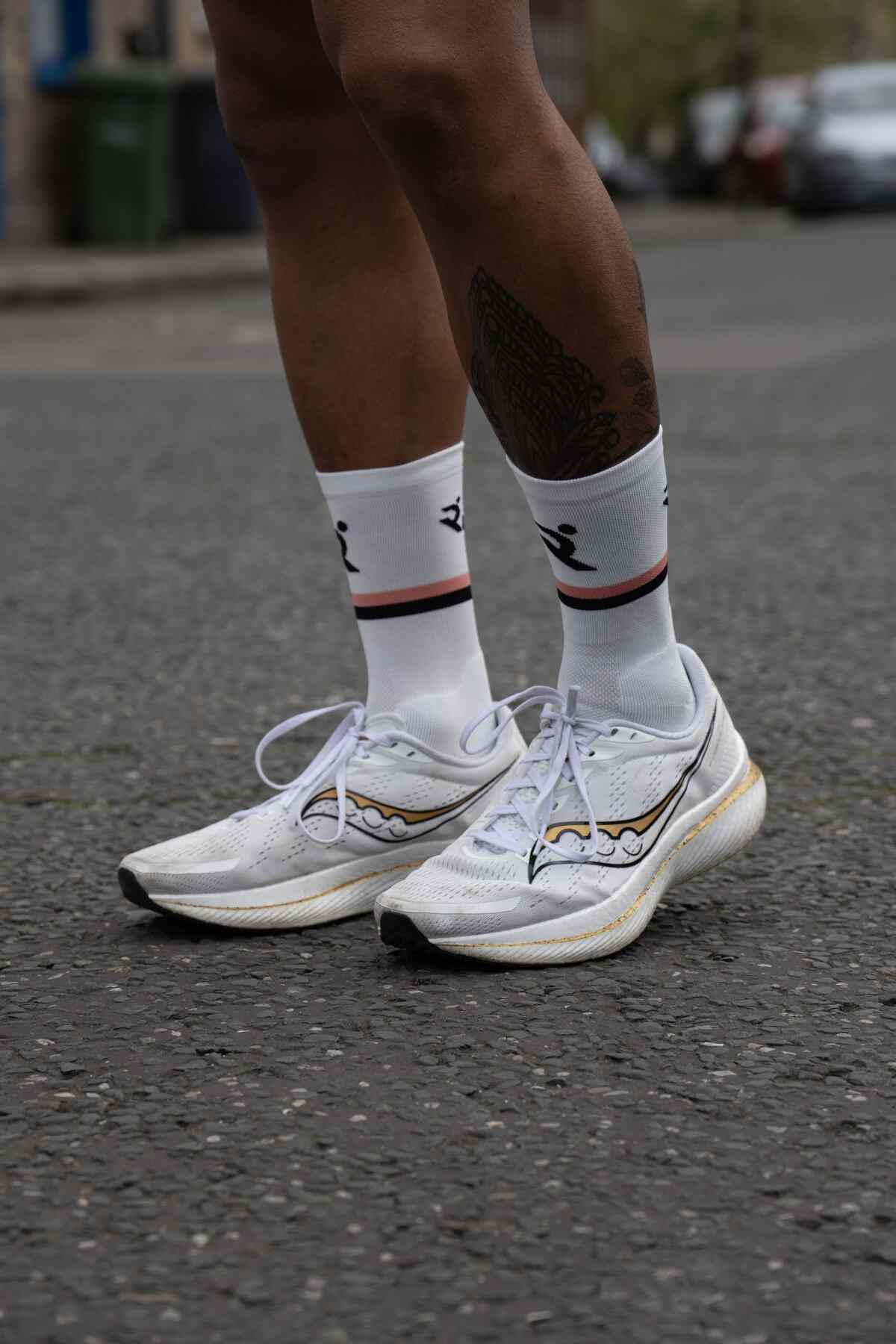
As featured in




Stories from Runnas
FAQs: All you need to know about completing a triathlon
Triathlon distance: how long is a triathlon?
There are a number of triathlon races you can compete in, and they vary a lot in terms of distance. Here are the most common ones:
• Ironman: 3.8 km swim, 180 km bike, 42.2 km run (226 km total)
• Half Ironman (70.3): 1.9 km swim, 90 km bike, 21.1 km run (113 km total)
• Olympic: 1.5 km swim, 40 km bike, 10 km run (51.5 km total)
• Sprint: 0.75 km swim, 20 km bike, 5 km run (25.75 km total)
How long will it take me to prepare for a triathlon?
This is highly individual and will depend on:
- Your overall fitness
- Your experience with endurance events and sports
- Your experience with each of the sports
- The specific race and the distances you’ll need to cover
- The time you have to prepare
- Your schedule and availability
Training for a triathlon typically takes anywhere from 10 to 26 weeks, based on all those factors. Consistency and accountability are key, as is having a solid triathlon training program.
To prepare for the running section of your next triathlon event, get one of Runna’s personalized triathlon running plans. Our plans are specifically designed for triathlon athletes and are built to fit into a busy training schedule, helping you prepare in the best way possible.
Which triathlon training plan should I pick?
The plan that’s ideal for you will depend on the type of race you’ll be competing in, its total distance, the time you have to train, and your current physical ability.
A custom triathlon running plan will take into account all this and help you prepare for the running section of your race in the best way possible. As experienced runners and triathlon athletes ourselves, we’ve made sure to build plans suitable for every athlete and every goal.
What triathlon finishing time should I aim for?
If it’s your first time, simply reaching the finish line is already an enormous achievement, so focus on making your experience as pleasant as possible – and, also, injury-free.
If you already have a few tri races under your belt, Runna’s personalized running plans for triathlon athletes will help you make the most out of your training and finish faster and stronger.
Triathlon training and injuries: What should I do if I'm recovering from an injury?
Triathlon training can be very demanding, so make sure you prioritize your own safety. If you’re recovering from an injury check with your doctor or physiotherapist if you can start preparing for a triathlon race. They’ll be able to advise you on the best approach and plan your recovery strategy with you.
Once you get their green light, you can use a triathlon training app like Runna to prepare for the running segment of your next race safely and without risking another injury.
Read more about post-injury training to make sure you’re training safely.
Triathlon and general fitness: Do I need to do strength training to prepare for a tri race?
Strength training is not an absolute must – but it’s certainly a great addition to any triathlon athlete’s training program. It’ll help you improve your performance across all three sports and prevent injuries.
All Runna’s plans feature optional strength training programs to help you prepare for your next tri race with the equipment you have available (even if you have none).
I'm not ready for my first triathlon yet. What's an easier goal I can aim for?
If you’d like to take part in a triathlon race in the future but aren’t ready to do that just yet, you can prepare for the running distance of the race while also progressively adding cycling and swimming to your training routine.
Unsure how to choose a running goal? Find out more about choosing the right running goal for you.
Inspiration
Top Running Tips for Triathlon Training
Here are some of our top tips to get you triathlon run ready.

Fueling During a Triathlon
Get the most out of your swim, bike, run by getting your fueling right!

Managing your running around triathlon training
We've covered everything you need to know to develop your running while training for a triathlon or IRONMAN



